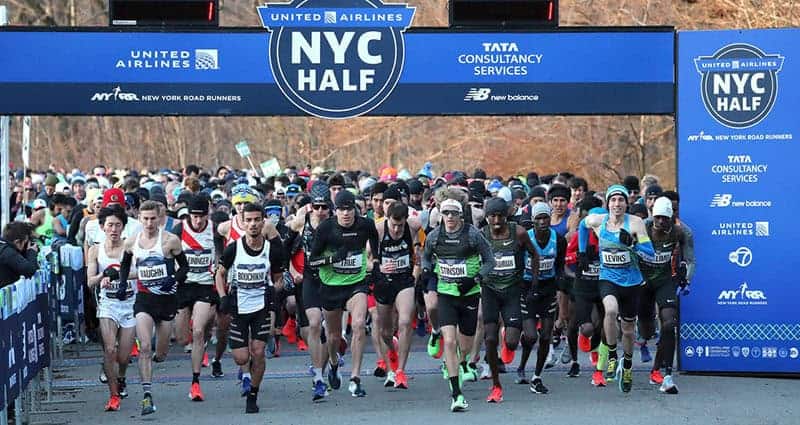Do you want to run a faster half marathon? Here’s how to improve your time.
The half marathon (HM) is a popular race distance because it’s long enough to earn respect but not quite as flattening as a full marathon—not by a long shot. We sometimes get the impression the HM sits somehow in the middle between the 10K and the marathon. It doesn’t. The half marathon is only 10 km longer than a 10K, but 20 km shorter than a marathon. Big difference!
Half marathon race pace is also more enjoyable than the rather ‘uncomfortable’ 5K and 10K paces. Yet, the half marathon is not a distance you can run just for fun without proper race preparation—even if you’re generally well-trained and athletic. I did that twice as a teenager, which wasn’t a good idea in both instances.
But if you are well-prepared, the HM is a great race to get out of bed for in the morning.
What is a Fast Half Marathon Time?
Everyone who completes a half marathon deserves respect for going the distance. But advanced runners would expect to run the HM under 1:30 hours, and Olympians in just under 1 hour.
What is the Half Marathon World Record?
Uganda’s Jacob Kiplimo, in 57:32 minutes, and Ethiopia’s Letesenbet Gidey, in 1:02:52 hours, hold the half-marathon world records. In the masters category, Titus Mamabolo ran the HM in 1:06:23 hours at age 50, and the great Ed Whitlock finished it with an equally respectable time of 1:38:59 hours at the ripe age of 80. The M50 for women stands at 1:15:18, achieved by Linda Somers, and Betty Jean McHugh holds the M80 age group record at 2:04:19.
While undoubtedly gifted, these athletes put in the work to make those remarkable finishing times happen.
What is the Average Half Marathon Time?
The average time to run a half marathon is approximately 1:45 hours for men and 1:56 hours for women across all age groups. But I like to categorize it further by training level under the age of 50. Though admittedly somewhat arbitrary, the following categories provide a good reference point:
Men
- Beginner: above 1:50
- Intermediate: 1:50 – 1:30
- Advanced: below 1:30
Women
- Beginner: above 2:00
- Intermediate: 2:00 – 1:40
- Advanced: below 1:40 [spacer height=”5px”]
What is Your Half Marathon Potential?
With world-class genetic potential, you’d finish the half marathon in 1:15 hours with a mere 4 running days per week. That’s roughly 2 percent of the population. Looking at it from the other extreme—the average runner (50th percentile) maxing out training from a young age—a race result approaching 1:15 is on the cards, too.
Almost nobody is doomed to be average other than by choice.
Half Marathon Training Zones
If you want to run a faster half marathon, there’s a lot of scope for improvement from different angles. Endurance, and especially muscular fatigue resistance, plays a large role and can be enhanced with higher mileage, an emphasis on tempo runs, and longer long runs. If you lack speed, you may have to work on stride power with regular hill sprints and a longer buildup of VO2 max intervals, which results in a faster pace across all training zones.
Endurance
If you recently stepped up to the half marathon from 5K or 10K races, you will notice the HM is an entirely different animal. Speed is helpful, but if that isn’t underpinned by sufficient weekly mileage and a substantial long run—including long progression runs—you will falter after 10 miles.
Lactate Threshold
The half marathon is raced slightly below your lactate threshold (LT). This means lactate can be cleared as fast as it is produced. However, it makes a massive difference whether your LT occurs at 70 or 85 percent of your VO2 max. The more you can shift your lactate turnpoint upwards, the faster your race pace, even if your VO2 max stays constant.
VO2 max
There is no race that wouldn’t benefit from a higher VO2 max, and the half marathon is no different. But unlike for 5K and 10K races, VO2 max training has to happen earlier in the training cycle as the final weeks are reserved for the more race-specific tempo runs. There’s also less emphasis on maximal aerobic capacity compared to shorter race distances.
Speed
Speed work is not the first thing that comes to mind when discussing half marathon training. But you wouldn’t want to have a grave weakness in muscular power either because that limits your potential for VO2 max training. It’s nothing you have to labor on, but you shouldn’t neglect.
Half Marathon Training Phases
Nothing plateaus your training faster than repeating the same weeks over and over, even if you increase your weekly mileage or make the individual workouts more challenging. The best recipe for continuous progress is a periodized training schedule that systematically moves from general to race-specific intensities.
General Conditioning
The general conditioning phase isn’t necessary for most runners, but it is a great starting point if you are coming back from injury or low-mileage training.
- Easy runs
- Hill sprints
Base Training
The base phase lasts 6 weeks and primarily focuses on increasing weekly easy mileage and gradually extending the long run. However, there’s also some running at marathon pace and a few surges at 3K—1500 m pace to transition seamlessly into the following training cycle.
Primary
- Easy runs
- Long runs
- Moderate runs
Secondary
- Marathon pace
- 3K pace
- 1500m pace
- Hill sprints
Support Training
The 6-week support phase is focused on enhancing VO2 max on the first workout of the week and the lactate threshold on the second workout three days apart. The long run on the weekend is often a progression run with a fast finish at marathon or half-marathon pace.
- Easy runs
- Long (progression) runs
- Marathon pace
- HM pace
- 15K pace
- 10K pace
- 5K pace
- Hill sprints
Race-Specific Training
The 4-week-long race-specific phase brings your half marathon race pace to a peak. The focus is on tempo runs with long segments at HM and lactate threshold pace, and long intervals at 10K pace to maintain VO2 max. Hill sprints make way for the more race-specific flat sprints.
- Easy runs
- Long runs
- HM pace
- 15K pace
- 10K pace
- flat sprints
Half Marathon Workouts
While the workouts for the half marathon are not wildly different from other race distances, there are some nuances to consider. Here’s an overview of the workouts and a possible progression during a half marathon race preparation.
Easy Runs
Easy runs are essential to log sufficient weekly mileage to absorb a long run approaching 12 miles and beyond. Therefore, I recommend a 5-day training week even for intermediate-level half-marathon runners. Easy should be at a conversational pace where speaking in full sentences is possible.
- 40 – 70 min @ easy pace
Long Runs
The long run is a critical element of half-marathon preparation. I speak of experience because I couldn’t get past a 1:24-hour HM in a particular season even though I had run a 34:32-minute 10K two weeks prior. Without substantial long runs, including add-ons at race pace, it’s impossible to muster the stamina for a race of that duration. As an advanced runner, you should go above 13 miles a few times during your HM buildup.
Here’s what the long run progression can look like:
- 75 min easy
- 90 min easy
- 105 min easy
- 45 min easy + 45 min moderate
- 120 min easy
- 60 easy + 15 moderate + 15 marathon pace
- 120 min easy
- 45 easy + 30 moderate + 15 HM pace
Tempo Runs
Tempo runs are the lifeblood of half-marathon training. Start with marathon pace for a solid foundation of the aerobic threshold (LT1) and gradually transition to lactate threshold (LT2) training as the weeks pass. In the final weeks, emphasize half-marathon race-specific workouts.
Here’s an example:
- 40 min @ marathon pace
- 35 min @ 30K pace
- 3x 10 min @ 15K pace w/ 2 min easy
- 25 min @ 15K pace
- 2x 20 min @ HM pace / 2 min easy
- 40 min @ HM pace
VO2 max Intervals
One dedicated VO2 max workout per week is enough to improve maximal aerobic capacity during a half-marathon training cycle. Unlike for 5K and 10K race preparation, you don’t need to cut the rest intervals as you approach race day, as those intensities aren’t race-specific. But you need a logical progression from shorter, faster intervals to longer, less intense work.
- 10x 400m @ 5K pace w/ 2 min jog
- 6x 600m @ 3K pace w/ 2:30 min jog
- 6x 800m @ 5K pace w/ 2:30 min jog
- 4x 1200m @ 10K pace / 3 min easy
- 5x 1000m @ 5K pace w/ 3 min easy
- 4x 1600m @ 10K pace w/ 3 min easy
Speed Repetitions
When it comes to speed work, the maxim for half-marathoners is that a little goes a long way. A few surges of 3K to 1500m pace added to a Fartlek session and a few hill sprints added to one or two easy runs are all that is needed.
Add-ons to Fartleks after every 800m of easy running:
- 8x 100m @ 1500m pace
- 8x 150m @ 1500m pace
- 10x 250m @ 3K pace
General speed work throughout the training cycle at the end of easy runs:
- 4 – 8x 10 sec hill sprints all-out (6 – 10 % grade)
- 4 – 8x 10 sec relaxed sprints @ 400m race pace
Half Marathon Race Strategy
You’ve put in the training hours. Now it’s important to get the taper, warm-up, and pacing strategy right to race your best.
Half Marathon Race Taper
The last long run should be 2 weeks before your race and the last hard workout no later than 10 days before you toe the starting line. After that, it’s all about fitness maintenance. During race week, focus on short intervals at 10K pace on your usual key workout days. That will prime your running economy for race day.
Half Marathon Warm-Up
Consider a short shakeout run at an easy pace the day before the race, followed by 2 – 3x 100m surges at 5K pace. That way, you won’t feel flat on race day. Don’t go above 3 miles to spare your glycogen stores. The warm-up routine on race day is not much different from your warm-ups for tempo runs. It consists of 5 minutes of easy running, dynamic stretches, 5 minutes of moderate running, and a few running drills.
Half Marathon Pacing Strategy
Once the starter gun goes off, there’s no need to battle for every inch. You have 13.1 miles ahead of you, with plenty of time to catch competitors. If you run above the target pace in the first 5 minutes, you will inevitably pay the price for it in the later stages of the race. Besides, picking up competitors in the final 3 miles who likely went out too fast is motivating. While it’s possible to race a half marathon without taking sports gels, I recommend fueling with half a gel every 3 miles. This sends a powerful signal to the brain that energy is supplied; therefore, a faster pace can be tolerated.
Post-Half Marathon Recovery
I recommend a short cool-down run after 5K and 10K races—but not the for the half marathon. Running that distance is a significant strain on your body, and additional mileage will not make you feel any better the following day. I also suggest you take 2 days off from running after the race or at least substitute running days with low-intensity bike rides. The first hard workout should only be resumed 10 days after the race if your half marathon was an all-out effort. As a rule of thumb, you can race the half marathon once a month, but exceptions apply.
Summary
- Set a goal with a 50% chance of achieving it
- Build a solid aerobic base initially
- Add a fast-finish to most long runs
- Emphasize various tempo runs
- Add some VO2 max and speed work
- Race at an even pace




